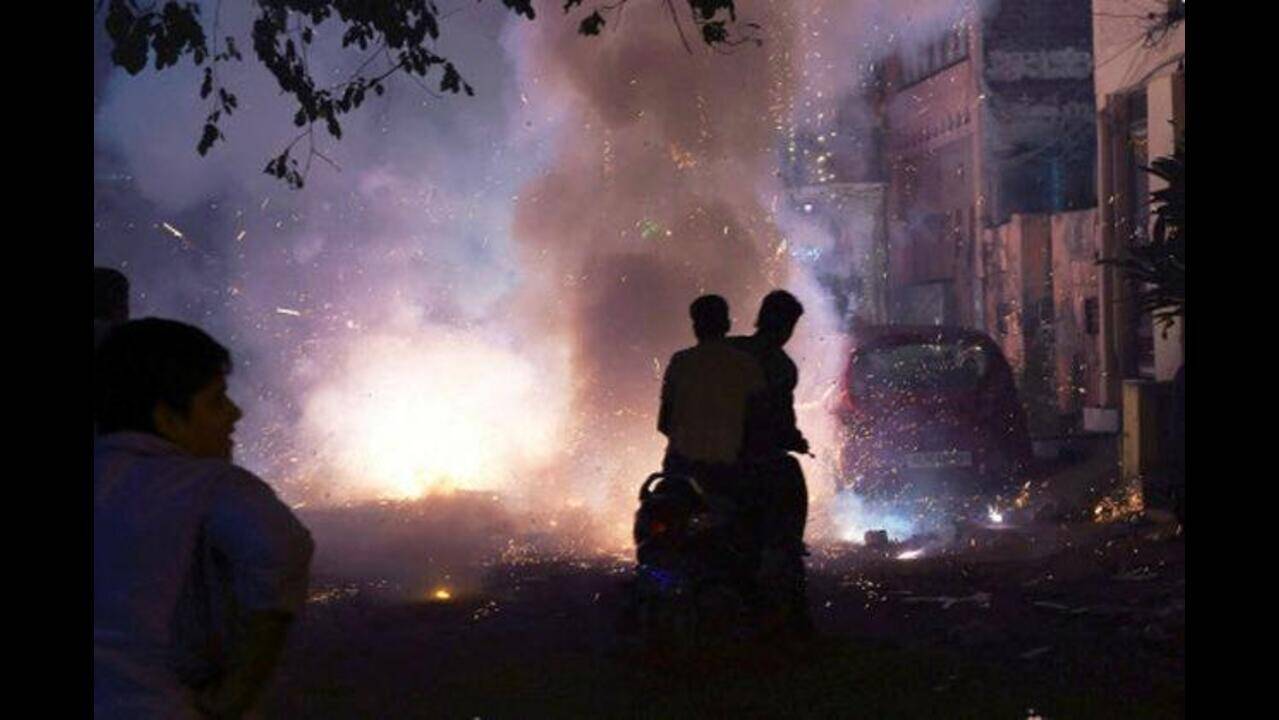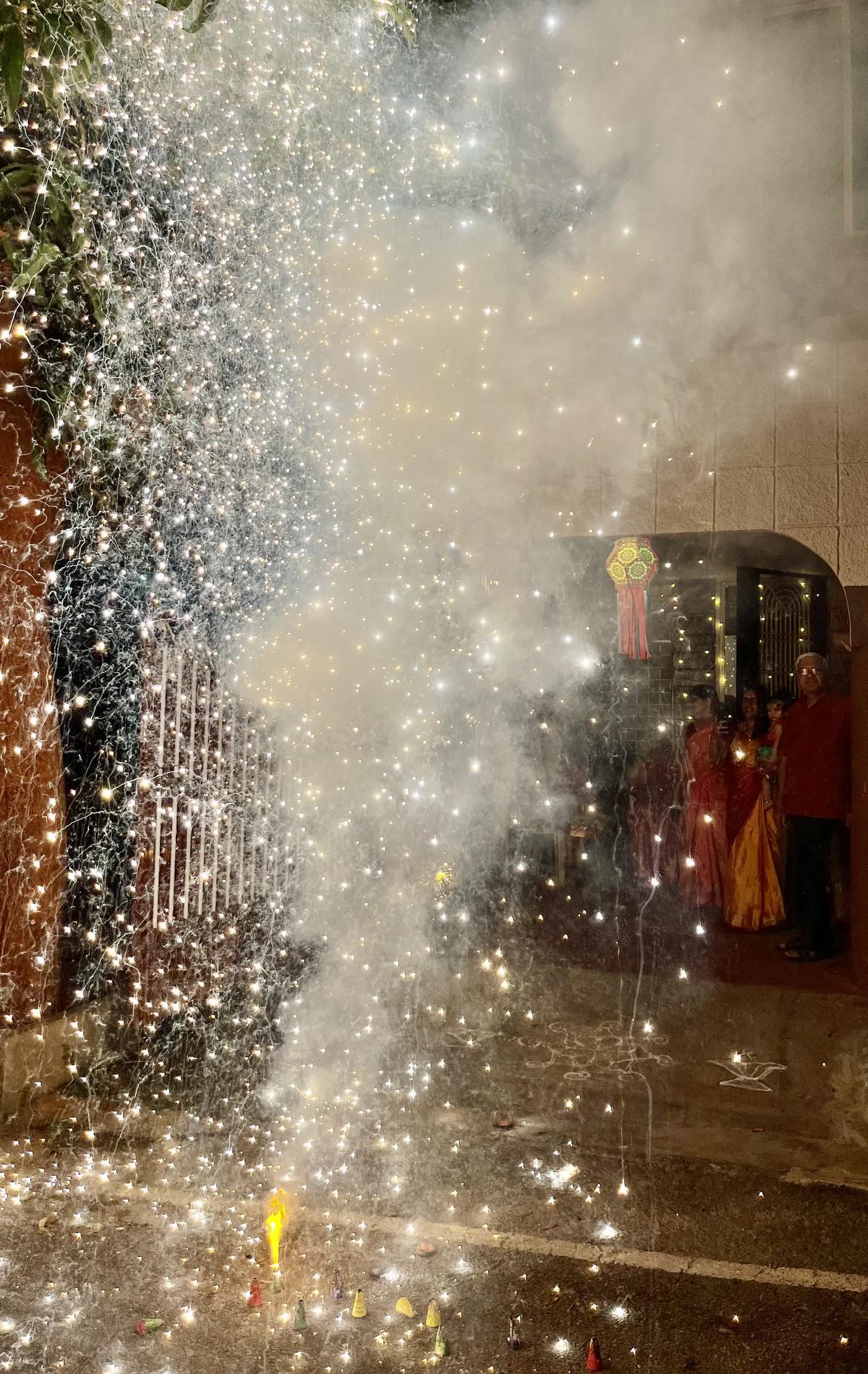Bengaluru witnessed a noticeable decline in air quality this Deepavali, with pollution levels moving from ‘good’ to ‘moderate,’ according to data from local air monitoring stations. The increase in particulate matter and other pollutants has been attributed primarily to the widespread bursting of firecrackers, combined with vehicular emissions and early morning industrial activity. While the air quality remains within permissible limits, experts caution that prolonged exposure can affect vulnerable groups, including children, the elderly, and individuals with respiratory conditions.
Authorities have reported elevated levels of PM2.5 and PM10 in several parts of the city, especially in densely populated residential and commercial areas. The Central Pollution Control Board (CPCB) guidelines classify these pollutants as harmful when sustained over time, potentially causing respiratory distress, eye irritation, and aggravating existing medical conditions. Environmentalists have stressed the importance of minimizing firecracker usage and promoting eco-friendly alternatives to maintain air quality during festival seasons.
Impact on Health and Daily Life: Air Quality
Medical professionals in Bengaluru have noted an uptick in patients experiencing breathing difficulties, coughing, and throat irritation during the Deepavali celebrations. Hospitals and clinics have advised individuals with asthma, bronchitis, or other respiratory issues to limit outdoor exposure and use protective masks when venturing outside. Public health authorities have also recommended increasing indoor air circulation through purifiers and keeping windows closed during peak pollution hours.
The decline in air quality has also affected outdoor activities and traffic movement in several parts of the city. Visibility has reduced slightly in areas with dense smoke accumulation, causing concerns for motorists and pedestrians alike. Authorities have urged drivers to exercise caution and use headlights during early morning and evening hours, when smoke from firecrackers tends to linger near roads and intersections.
Environmental monitoring agencies have pointed out that Bengaluru’s topography and weather conditions exacerbate the accumulation of pollutants during festive periods. Calm winds, low temperatures, and stagnant air traps particulate matter close to the ground, contributing to temporary but noticeable declines in air quality. Experts recommend timely public advisories to help residents adjust outdoor activities accordingly and reduce health risks.

Public response has been mixed, with many citizens acknowledging the cultural significance of firecrackers while also expressing concern over their environmental impact. Social media campaigns advocating “green Deepavali” have gained traction, encouraging families to adopt quieter and less polluting celebration methods. Such initiatives aim to strike a balance between tradition and environmental responsibility.
The Karnataka State Pollution Control Board (KSPCB) has increased surveillance during the festive period, deploying mobile monitoring units and issuing public warnings regarding air quality. Authorities have also coordinated with local police to ensure adherence to firecracker regulations, particularly in residential areas and near schools and hospitals. Non-compliance can result in fines or legal action, reinforcing the importance of regulated celebrations.
Meteorological departments have forecast that air quality may gradually improve over the next few days as wind speeds increase and dispersed pollutants settle. However, environmentalists caution that repeated incidents of firecracker-related pollution can have cumulative effects on public health and urban ecosystems. Long-term measures, including stricter regulation, public awareness, and promotion of alternatives, are considered essential to mitigate seasonal air quality deterioration.
Schools and educational institutions have been advised to monitor outdoor activities for children, particularly during peak firecracker hours in the evening. Many schools have already implemented indoor Diwali celebrations to protect students from smoke exposure. Teachers and parents are encouraged to educate children about the environmental and health implications of excessive firecracker use, promoting safer celebration practices.

In conclusion, Bengaluru’s shift from ‘good’ to ‘moderate’ air quality during Deepavali highlights the environmental challenges posed by festive activities combined with urban pollution sources. Authorities, healthcare professionals, and citizens are urged to collaborate in reducing the impact, through regulated celebrations, public awareness, and adoption of eco-friendly alternatives. This approach aims to preserve both cultural traditions and public health, ensuring that the city can celebrate festivities without compromising environmental safety.
Officials have reiterated that while moderate air quality does not pose immediate danger to healthy individuals, cumulative exposure and vulnerable populations remain at risk. Continuous monitoring, timely advisories, and responsible public behavior are being emphasized to maintain sustainable air quality levels during festival seasons, balancing tradition with health and environmental considerations.

Authorities have emphasized that the moderate air quality recorded in Bengaluru is primarily a temporary spike linked to festival activities, but repeated seasonal deterioration can have long-term health implications. Chronic exposure to particulate matter, even at moderate levels, may contribute to respiratory illnesses, cardiovascular issues, and exacerbation of allergies. Public health experts recommend that citizens, especially vulnerable groups, take precautionary measures during this period to reduce exposure and protect overall well-being.
Environmentalists have pointed out that urban centers like Bengaluru face compounded pollution challenges during festivals due to a combination of firecracker emissions, vehicular exhaust, and industrial pollutants. The increase in PM2.5 and PM10 particles is particularly concerning because these microscopic pollutants can penetrate deep into the lungs and bloodstream, triggering inflammation and other health complications. Awareness campaigns stress the need for minimizing unnecessary emissions during such periods.
The Karnataka State Pollution Control Board (KSPCB) has deployed additional air quality monitoring units across key city zones to provide real-time data to the public. Alerts are shared through mobile apps, social media, and public broadcast channels to inform citizens about pollution levels and recommend protective measures. These steps aim to make residents more conscious of their surroundings and adjust outdoor activities accordingly.
Medical practitioners have reported a rise in emergency room visits for respiratory issues during the early hours of Deepavali. Many patients exhibited symptoms such as shortness of breath, wheezing, and eye irritation. Hospitals have advised people to maintain indoor air quality using air purifiers and avoid outdoor exposure, especially during peak firecracker activity between evening and midnight. Vulnerable populations, including children, senior citizens, and individuals with pre-existing respiratory conditions, have been urged to exercise particular caution.
Vehicular traffic has also been affected due to reduced visibility caused by smoke and haze in areas with high firecracker density. Authorities have warned drivers to use low beams and maintain safe distance, particularly on busy roads and intersections. Traffic police are coordinating with environmental agencies to monitor high-risk zones and ensure that congestion does not exacerbate pollution exposure.
The role of local communities in mitigating air pollution during festivals has become increasingly significant. Many neighborhood groups have organized “green Deepavali” initiatives, encouraging residents to replace traditional firecrackers with eco-friendly alternatives or symbolic celebrations. Such initiatives are gaining traction as awareness of environmental and health impacts grows among the public.
Educational institutions have incorporated environmental awareness sessions in their festival programs. Schools are guiding students to celebrate responsibly, focusing on arts, crafts, and cultural performances rather than fireworks. These measures aim to instill long-term behavioral change among younger generations and foster a culture of environmentally conscious celebrations in urban areas.
Industrial emissions have also contributed to the observed dip in air quality. Factories and small-scale industries in and around Bengaluru release particulate matter and smoke, which, when combined with festival-related pollutants, intensifies the air quality decline. Experts suggest stricter monitoring of industrial emissions during festival periods to reduce cumulative effects on urban air quality.
Meteorological factors play a crucial role in determining pollution dispersion. During Deepavali, low wind speeds and temperature inversions often trap pollutants close to the ground, exacerbating air quality deterioration. Authorities are using predictive models to anticipate pollution peaks and issue timely advisories, helping residents plan outdoor activities more safely.
Public health campaigns have emphasized the importance of masks capable of filtering particulate matter during high pollution periods. Experts recommend N95 or similar masks for individuals venturing outdoors during the festival peak. These measures are particularly crucial for vulnerable groups to minimize inhalation of harmful pollutants.
Citizen engagement has proven effective in promoting environmentally responsible celebrations. Social media campaigns, local awareness drives, and public pledges to avoid excessive firecracker use have led to visible reductions in certain city areas. Authorities encourage continued participation to gradually shift cultural practices toward safer and eco-friendly alternatives.
Waste management following festival activities is another factor influencing urban air quality. Residues from firecrackers, including burnt papers, plastics, and chemical deposits, contribute to secondary pollution if not cleared promptly. Municipal authorities have deployed additional cleaning teams to ensure streets, public spaces, and water bodies are restored quickly, preventing further environmental degradation.
Long-term policy recommendations emerging from air quality observations include stricter regulations on permissible firecracker types, timing restrictions, and public incentives for eco-friendly celebrations. Experts also advocate for integrating pollution management into festival planning at both municipal and state levels to reduce recurring spikes in particulate matter.
Finally, the moderate air quality in Bengaluru during Deepavali serves as a reminder of the delicate balance between cultural traditions and environmental responsibility. Authorities, environmentalists, and citizens are encouraged to collaborate to minimize pollution while preserving the spirit of the festival. Awareness, regulation, and individual responsibility together form the cornerstone of sustainable and safe celebrations in urban India.
Follow: Karnataka Government
Also read: Home | Channel 6 Network – Latest News, Breaking Updates: Politics, Business, Tech & More

